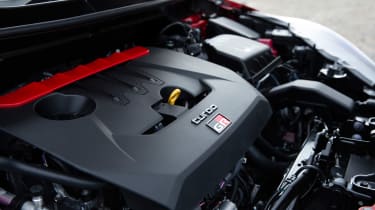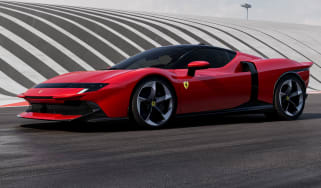Toyota GR Yaris – engine, gearbox and technical highlights
The 1.6-litre triple is a little gem of an engine, and bespoke to the GR Yaris
Toyota has liberated an extra 19bhp and 23lb ft from the purpose-designed G16E-GTS 1.6-litre three-cylinder engine, up to 276bhp and 288lb ft from the 257bhp and 265lb ft figures of the original. The engine upgrades deliver strength as well as power, with a stronger valvetrain, new exhaust valve material, increased fuel injection pressure and stronger pistons, all tested in the Japan Rally Championship. All new European cars also get a cooling pack as standard, with an additional sub-radiator and a water spray system for the intercooler, triggered by a button on the dash.
That power is sent to all four wheels via the GR-Four all-wheel-drive system, the logo of which now printed prominently on the new car’s front sub-radiator. Though the first the GR Yaris was exclusively a manual, with the update, an eight-speed automatic is now available.
There are three settings for the permanent all-wheel-drive system, which splits torque front to rear via an electronically controlled coupling. The torque splits have been revised in the new car: Normal mode divvies torque 60:40 front:rear, but in Track mode the balance shifts actively between 60:40 and 30:70, apportioning more to the rear on corner exit. There’s also a Gravel mode, which nominally splits torque at 53:47. In the old car, normal equates to a 60:40 torque split with a front bias, Sport flips that with a 30:70 split, and Track is 50:50.
There’s so much to say about the technical make-up of the GR Yaris, starting with its unique structure. Essentially, the GR Yaris is a combination of base Yaris structure up front (GA-B) and the slightly larger Corolla/C-HR (GA-C) at the rear. This wider rear track has allowed Toyota to design a totally bespoke rear suspension design with double-wishbones that both allow for the rear-axle drive shafts and the fitment of a rear locking differential. A double wishbone design also allowed engineers more freedom with the GR's camber and castor adjustments, fine tuning the setup exactly the way it wanted it. The front suspension still uses a relatively mundane MacPherson strut design, but the geometry is completely different to a basic Yaris.
Overall, this makes the GR Yaris body 90mm lower and 55mm wider than a standard Yaris, sharing only its front and rear lamps, and its door mirrors. Yes, it may be a small, three-door (hurrah!) hatchback, but the GR is a very special piece of kit designed specifically for the intended job. It's so specialised that the GR Yaris is built largely by hand in the same specialised facility within Toyota City in Japan that was preciously used in the construction of the Lexus LFA. Unfortunately, the LFA's spectacular three-dimensional carbon loom isn't used for the GR's construction, but it does feature a carbonfibre-reinforced plastic roof skin, plus the use of aluminium for the doors and bonnet.
The Gen 2 car has stiffer spring rates, by 28 per cent at the front, 11 per cent at the rear, and an uprated front anti-roll bar and extra bolts fastening the front dampers to the body, which is also intended to improve steering response and feel. That’s aided and abetted by a stiffer bodyshell than before, with a 15 per cent increase in the number of spot welds and amount of adhesive applied to the structure.




